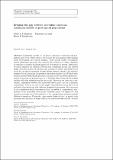Files in this item
Bridging the gap between individual-based and continuum models of growing cell populations
Item metadata
| dc.contributor.author | Chaplain, Mark Andrew Joseph | |
| dc.contributor.author | Lorenzi, Tommaso | |
| dc.contributor.author | Macfarlane, Fiona Ruth | |
| dc.date.accessioned | 2020-06-09T23:34:59Z | |
| dc.date.available | 2020-06-09T23:34:59Z | |
| dc.date.issued | 2020-01 | |
| dc.identifier | 259301084 | |
| dc.identifier | 381bb8b1-279e-4a83-87b4-ddde772a1e50 | |
| dc.identifier | 85067278339 | |
| dc.identifier | 000514189300014 | |
| dc.identifier.citation | Chaplain , M A J , Lorenzi , T & Macfarlane , F R 2020 , ' Bridging the gap between individual-based and continuum models of growing cell populations ' , Journal of Mathematical Biology , vol. 80 , no. 1-2 , pp. 343-371 . https://doi.org/10.1007/s00285-019-01391-y | en |
| dc.identifier.issn | 0303-6812 | |
| dc.identifier.other | ORCID: /0000-0001-5727-2160/work/58531630 | |
| dc.identifier.other | ORCID: /0000-0003-2242-7745/work/60196607 | |
| dc.identifier.uri | https://hdl.handle.net/10023/20063 | |
| dc.description | Funding: FRM is funded by the Engineering and Physical Sciences Research Council (EPSRC) (Grant No. EP/N014642/1). | en |
| dc.description.abstract | Continuum models for the spatial dynamics of growing cell populations have been widely used to investigate the mechanisms underpinning tissue development and tumour invasion. These models consist of nonlinear partial differential equations that describe the evolution of cellular densities in response to pressure gradients generated by population growth. Little prior work has explored the relation between such continuum models and related single-cell-based models. We present here a simple stochastic individual-based model for the spatial dynamics of multicellular systems whereby cells undergo pressure-driven movement and pressure-dependent proliferation. We show that nonlinear partial differential equations commonly used to model the spatial dynamics of growing cell populations can be formally derived from the branching random walk that underlies our discrete model. Moreover, we carry out a systematic comparison between the individual-based model and its continuum counterparts, both in the case of one single cell population and in the case of multiple cell populations with different biophysical properties. The outcomes of our comparative study demonstrate that the results of computational simulations of the individual-based model faithfully mirror the qualitative and quantitative properties of the solutions to the corresponding nonlinear partial differential equations. Ultimately, these results illustrate how the simple rules governing the dynamics of single cells in our individual-based model can lead to the emergence of complex spatial patterns of population growth observed in continuum models. | |
| dc.format.extent | 934733 | |
| dc.language.iso | eng | |
| dc.relation.ispartof | Journal of Mathematical Biology | en |
| dc.subject | Growing cell populations | en |
| dc.subject | Pressure-driven cell movement | en |
| dc.subject | Pressure-limited growth | en |
| dc.subject | Individual-based models | en |
| dc.subject | Continuum models | en |
| dc.subject | QA Mathematics | en |
| dc.subject | QH301 Biology | en |
| dc.subject | T-NDAS | en |
| dc.subject.lcc | QA | en |
| dc.subject.lcc | QH301 | en |
| dc.title | Bridging the gap between individual-based and continuum models of growing cell populations | en |
| dc.type | Journal article | en |
| dc.contributor.sponsor | EPSRC | en |
| dc.contributor.institution | University of St Andrews. Applied Mathematics | en |
| dc.contributor.institution | University of St Andrews. School of Mathematics and Statistics | en |
| dc.identifier.doi | https://doi.org/10.1007/s00285-019-01391-y | |
| dc.description.status | Peer reviewed | en |
| dc.date.embargoedUntil | 2020-06-10 | |
| dc.identifier.grantnumber | EP/N014642/1 | en |
This item appears in the following Collection(s)
Items in the St Andrews Research Repository are protected by copyright, with all rights reserved, unless otherwise indicated.

